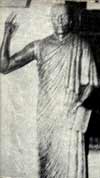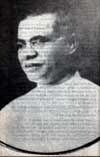The historic Panadura Debate The historic Panadura Debate between the Buddhists and the Christians took place exactly 133 years ago - on August 26 and 28, 1873. Before that, several debates were held and each was identified by the place where it was held. After three major debates at Baddegama (1865), Udanwita (1866) and Gampola (1871), the fourth which turned out to be the most notable was held in Panadura.
The two key persons in the Panadura Debate were Migettuvatte Gunananda Thera for the Buddhists and Father David de Silva for the Christians. Gunananda Thera was acclaimed as a debater of a very high order after this debate and his personality deeply affected the resurgence of Buddhism which was to follow. He was described as "the boldest, most brilliant and most powerful champion of Sinhalese Buddhism" and the leader of the Buddhist revival. The Panadura Debate was the climax of the first phase of the revivalist movement which began with the establishment of the 'Society for the Propagation of Buddhism' at Kotahena and the establishment of the Lankopakara Press in Galle. Both events took place in 1862. In the meantime, another sect, the Ramanna Nikaya had been established in 1865 and the Vidyodaya Pirivena, the first leading centre of oriental learning was founded in 1872. It was the success of the Panadura Debate that prompted Colonel H. S. Olcott to come to Ceylon. He was impressed with what he read in the newspapers in the United States on the Debate and immediately sent a mass of pamphlets and other literature which were very critical of Christianity. Gunananda Thera got these translated into Sinhalese and distributed them all over the island. The Panadura Debate thus created quite a stir not only in this country but in many parts of the world.
A nationalist is born The birth of a prominent personality who fought hard to protect traditional values and prevent the undue influence of western culture happened on August 31, 1875. He was Piyadasa Sirisena who used his pen to forcefully communicate the strong feelings he held about the need to preserve our heritage.
The pioneer Sinhala novelist and newspaper editor put out a strong nationalist message. Starting his journalistic career as a sub-editor in the journal, 'Sithumina' in 1895 having come to Colombo from his village Aturuwella in Induruwa, he started editing his own journal 'Sinhala Jatiya' in 1903, which became a weekly newspaper two years later. The newspaper took up issues which concerned the Sinhalese very strongly. It supported the temperance movement which began in 1912 against the Excise Act. He was among the national leaders who were imprisoned during martial law following the 1915 riots. Serving a prison term only strengthened his desire to fight the imperialists and by 1930, 'Sinhala Jatiya' became a popular Sinhala daily newspaper. Though it ceased publication due to economic reasons, it was restarted as a weekly in 1936 and continued until his death in 1946. He effectively used the novel, the verse, the newspaper and oratory to spread the nationalist message. He published his first novel, 'Jayatissa ha Roslin' (also known as 'Vasanavanta Vivahaya' - Lucky marriage) in 1906. It turned out to be an extremely popular piece of fiction and was published five times. It sold 25,000 copies. There are 18 novels to his credit. Among them are 'Apata Veccade', 'Maha Viyawula', ' ‘Taruniyakage Premaya', ' Yantham Gelavuna', 'Suchiritadarshaya', ' Chintha Manikyaratnaya', 'Anthima Kemetta', 'Pasan Niwasa' and ' Dingiri Menika'. Though he was well known as a novelist, his first creative effort was a book of poetry - 'Ovadan Mutuwela' - written in 1905. It was a book of advice and consisted of 164 verses.
|
||||||
Copyright © 2006 Wijeya Newspapers
Ltd. All rights reserved. |

